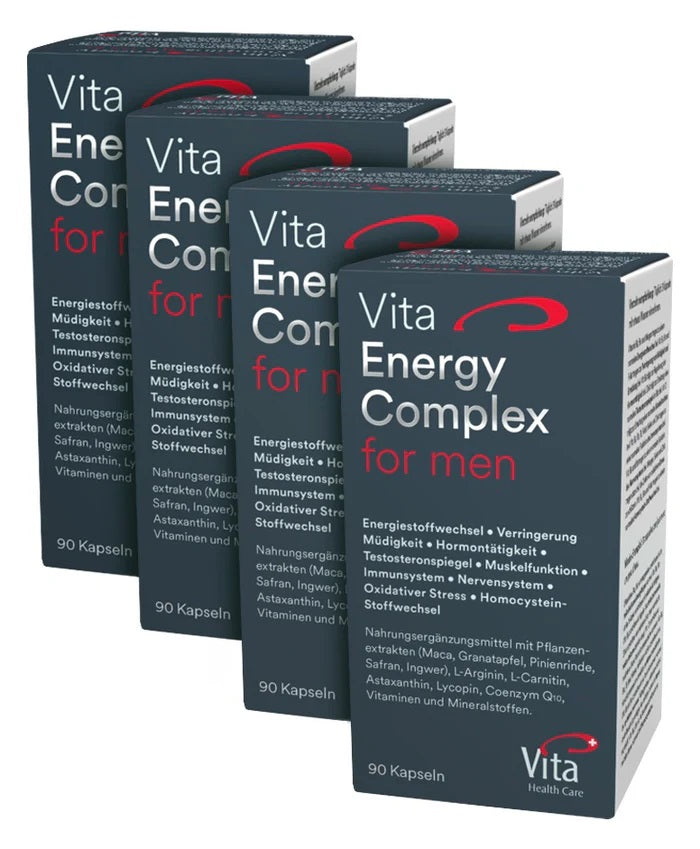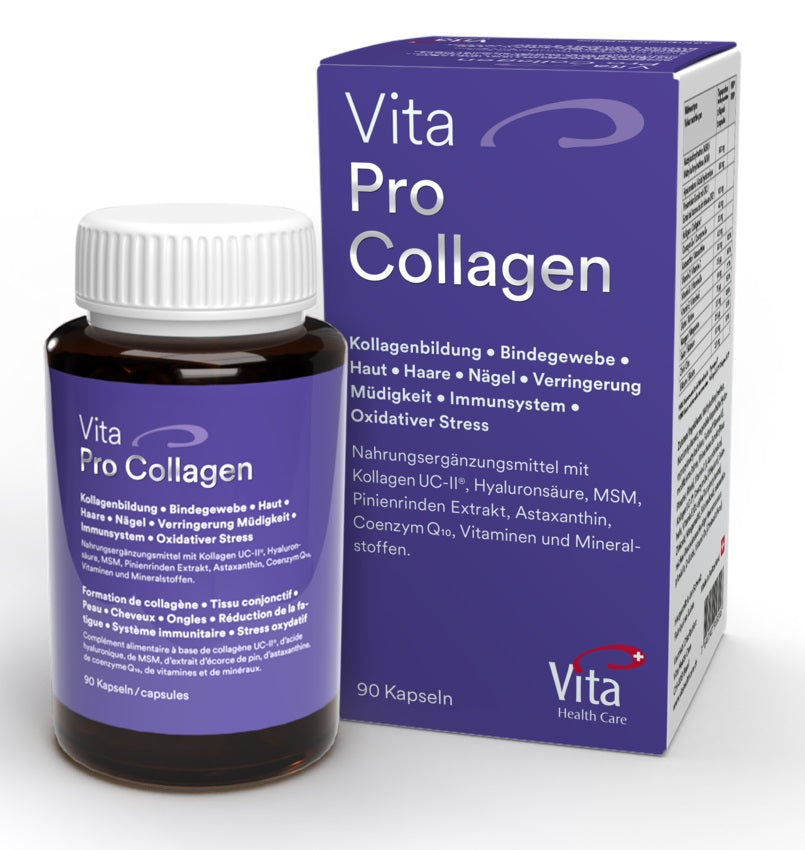


Vita Mobility Complex
Tax included. Shipping calculated at checkout
laktosefrei
für Diabetiker
glutenfrei
In stock - at your home in 3-4 working days
So that exercise is fun again!
Building blocks for articular cartilage
Glucosamine sulfate and chondroitin sulfate are natural, highly concentrated amino sugars that can be synthesized from food by a healthy and youthful organism and are important as basic building blocks for joint cartilage, tendons, ligaments and bone structures, but also for connective tissue and arterial walls.
As we age, it becomes increasingly difficult to provide the body with a sufficient amount.

- Osteoarthritis (wear and tear, degeneration of the articular cartilage) is incurable!
- Vita Mobility Complex offers a natural way to treat joint pain.
- The highly effective active ingredients can help maintain joint mobility in cases of osteoarthritis.
Scope of application
Product details
Active ingredients
Mode of action
Structural modification in osteoarthritis
New long-term clinical studies with glucosamine sulfate show a modification of symptoms and structure (disease modification) in osteoarthritis.
Study situation
- Register JY et al., Lancet 2001; 357: 251-56 : A randomized, placebo-controlled, double-blind 3-year study shows that glucosamine sulfate alleviates the symptoms of gonarthrosis, prevents structural changes in the knee joint, and delays the progression of the disease.
- Pavelka K et al., Arch Intern Med 2002; 162: 2113-23 : Confirmed these results in a similarly structured study.
WOMAC Index
Primary efficacy parameters: The WOMAC index (Western Ontario and McMaster Universities Osteoarthritis Index) assesses pain, stiffness and joint function.
After 3 months of treatment with glucosamine sulfate or glucosamine sulfate + NSAIDs, the improvement in symptoms persists for at least 2 months. After discontinuation of NSAIDs, their symptomatic benefit quickly disappears.
Compatibility
The tolerability of glucosamine is comparable to that of placebo and surpasses conventional NSAIDs. While combining it with NSAIDs does not increase their freedom from side effects, it can improve compliance.
Comparative studies
- Glucosamine sulfate vs. ibuprofen : Müller-Fassbender 1994 – 200 patients, 4 weeks, no differences in efficacy; however, >35% gastrointestinal side effects with ibuprofen.
- Glucosamine sulfate vs. paracetamol : Herrero 2005 – European study, 318 patients: Glucosamine sulfate worked better than paracetamol and improved mobility more.
- Chondroitin sulfate vs. Diclofenac : Morreale P. et al., 1996 – Pain relief from chondroitin initially slower, but after months stronger and more sustained than with diclofenac.
- Glucosamine + Chondroitin Sulfate vs. Celecoxib : Clegg et al., 2006 – The effect of the combination (1500mg/1200mg) is comparable to Celecoxib (200mg) in treating moderate to severe osteoarthritis pain.
Sulfa-Form: Why?
New publications show: The sulfated form of glucosamine is crucial for clinical efficacy and the stability of connective tissue. Glucosamine hydrochloride showed no significant differences versus placebo.
- Sulfur is essential for proteoglycan biosynthesis and joint function (Om-Journal for Orthomol. Med. 2007; 1:1, 6-10, Danesch. U.)
- Glucosamine for osteoarthritis: only the sulfate form shows an effect on joint function (Swiss Journal of Holistic Medicine, Vol. 19, 3/2007).
- Cochrane Review 2005: 20 studies, more than 2500 patients: analgesic effect of glucosamine sulfate clearly demonstrable, but not for glucosamine hydrochloride.
GAIT study (Clegg et al., NEJM 2006)
Subgroup with painful knee osteoarthritis (WOMAC pain score 301-400). Placebo, glucosamine, chondroitin sulfate, combination, and celecoxib were compared over 24 weeks.
Results (modified WOMAC pain score):
- Placebo: -123
- Glucosamine: -141
- Chondroitin sulfate: −120
- Glucosamine + Chondroitin: -177.5
- Celecoxib: -153.2
Stiffness (WOMAC): Similarly favorable changes for glucosamine, chondroitin sulfate, and celecoxib.
Function: Strongest improvement with the combination of glucosamine + chondroitin sulfate and celecoxib.
Overall, clinical studies show that glucosamine sulfate and chondroitin sulfate are effective, well-tolerated alternatives to classic painkillers for osteoarthritis – and their effect is often comparable or more lasting in studies.
Nutritional information table
| Vita Mobility Complex | ||||
| Nutritional value per | 3 Capsules | per 100g | NRV * | |
| Energy value kJ/kcal |
20/5 | 392/98 | ||
| Protein | 0.5 g | 9.8 g | ||
| Carbohydrates | 0.7 g | 23.3 g | ||
| Fat | < 0.1 g | < 1 g | ||
| Copper | 0.5 mg | 16.6 mg | 50% | |
| Manganese | 2.0 mg | 39.2 mg | 100% | |
| Chrome | 20 µg | 392 µg | 50% | |
| Glucosamine | 750 mg | 14.7 mg | ||
| Chondroitin sulfate | 550 mg | 9.8 mg | ||
* NRV: % of the reference value according to EU directive.
Allergy Information
ohne Gentechnik
enthält Gluatminsulfat aus Schalentieren
ohne Konservierungsstoffe
für Diabetiker
ohne künstliche Farbstoffe
laktosefrei
glutenfrei
zuckerfrei
Media
Choose options



Vita Mobility Complex
Information about the responsible person (Information obligations regarding the GPSR Product Safety Regulation)
Friedrich Hosbach
Church Lane 3
79618 Rheinfelden (Baden)
GERMANY
Phone +49 (0)7623 50288
Email gpsr.friedrichhosbach@gmail.com


Lose weight
Body Shape Review
I have been taking the Body-Shape Drinks for about 5 weeks and am very surprised by the very positive results!
I take two drinks daily (usually in the morning and at noon). I've already lost 7 kilos , even though I sometimes eat something substantial on the weekend and have a glass of wine. In addition, I've already lost about 5 cm in waist circumference. It really does attack even the stubborn fat deposits.
By the way, I don't feel hungry in between meals either – the drinks are very filling and satisfying. I mix the powder with about 1 dl of water and 1.5 dl of almond milk, that's how I like it best. - Katja S. Basel, (May 2025)

Keeps you young, fit and vital.
For beauty from within.
With MSM, hyaluronic acid, pine bark extract with OPC, astaxanthin, biotin, Collagen UC-II™, vitamin C, D plus E and other active ingredients, it is new and also unique on the market in terms of composition, dosage and effect.
Over 300 studies demonstrate a wide range of applications, such as for healthy mucous membranes, strong hair, healthy nails, musculoskeletal pain, rheumatoid arthritis, muscle pain, fibromyalgia, tendinitis, bursitis, lower back pain, degenerative joint diseases, collagen and hyaluronic acid production, skin, acne, hyperpigmentation, allergies, diabetes, erectile dysfunction, and menopausal symptoms.

Subheading
Vita products
Vita preparations with multifunctional effects
Vita Health Care AG, Basel, is our exclusive partner for all nutritional supplements. All products were developed in Switzerland, based on scientific studies and incorporating experience from medical practice. Production also takes place in Switzerland.
Countless users (including professional athletes) benefit from the top quality of these unique Swiss products.
The main difference between Vita products and single-ingredient preparations lies in the complex formulation. Combination preparations are products that contain several active ingredients and are tailored to specific needs. The advantages of such complex products are obvious and also make economic sense.

Model Luisa Rossi on Vita Collagen Complex Plus
More products
Anti-aging
Discover
Our product areas
Experience reports
This is what our customers say.
After a few days, a significant improvement occurred, and after a month of consistently taking it, I am now completely pain-free, can put stress on my knee like I haven't been able to for years, and the mobility of my knee is as good as my healthy knee.
Esther S.
Thanks to your products, I avoided a major operation. I can continue my sporting activities.
Dr. MB
To make a long story short: GENIUS! I'm feeling much better all around. Neck, shoulder, elbow, and heel – everything has improved. With the heel, I don't even remember anymore whether I had pain on the left or right side. My shoulder and neck allow me to sleep through the night again. I also bought a new pillow and go for regular massages, which may have also helped.
Ritschi

Saving money
Multi-pack offers
Multi-packs for you and your community.
We offer the following discounts on the recommended retail price:
8% quantity discount for 2 packs
13% quantity discount for 3 packs
19% quantity discount for 4 packs

Anti-aging

Joints

immune system














